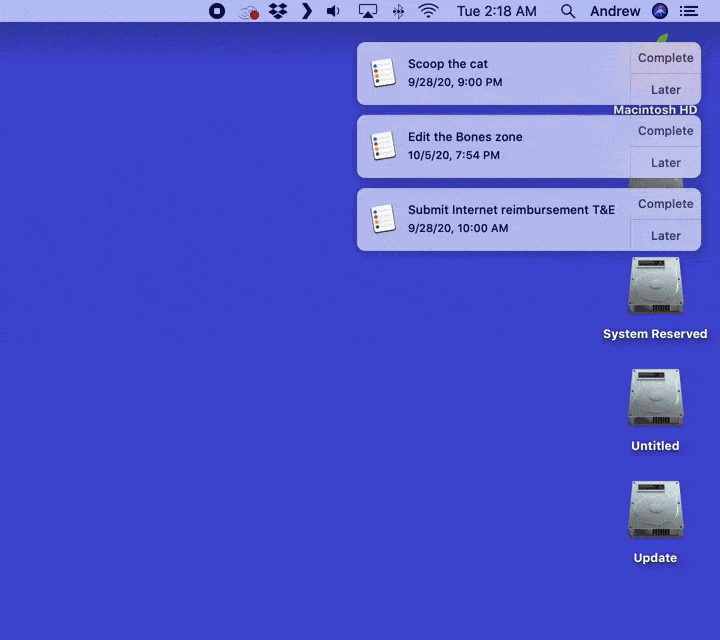Cat Part.i(o) Mac OS
- Cat Part.i(o) Mac Os Catalina
- Cat Part.i(o) Mac Os Update
- Cat Part.i(o) Mac Os Download
- Cat Part.i(o) Mac Os X
This tutorial provides step-by-step instructions to install OpenCV 4 (with Python bindings) on your macOS machine. OpenCV 4 was released on November 20th, 2018. I originally wrote this blog post when the alpha version was released, and it has now been updated on November 30th, 2018 to support the official release. Click to launch the gallery. 5 Other Cat Names Apple Could Have Picked For OS X 10.9. The other Apple OS X versions have all been named after wild cats. 10.9 is called Mavericks.
Teletype for Atom
Great things happen when developers work together—from teaching and sharing knowledge to building better software. Teletype for Atom makes collaborating on code just as easy as it is to code alone, right from your editor.
Share your workspace and edit code together in real time. To start collaborating, open Teletype in Atom and install the package.
For Macintosh (OS 10.5 and higher) Systems. From the dock, select System Preferences. Select the Network applet. Select Ethernet from the left hand side. Click on Advanced from the lower right. For OS X 10.8 or 10.9: Select the Hardware tab. The MAC Address should be listed. For other OS X: Select the Ethernet tab. If this does not work the best thing to do is to copy the output of show cam dynamic vlan# on an text editor and to look for the MAC address in the above format. Some newer catos are able to accept also the MAC format aaaa.bbbb.cccc that is used on IOS LAN switches in. Apple uses cat names to represent versions of OS X. It is important to know both the cat name and the version number of OS X that yo.
GitHub for Atom
Cat Part.i(o) Mac Os Catalina
A text editor is at the core of a developer’s toolbox, but it doesn't usually work alone. Work with Git and GitHub directly from Atom with the GitHub package.
Create new branches, stage and commit, push and pull, resolve merge conflicts, view pull requests and more—all from within your editor. The GitHub package is already bundled with Atom, so you're ready to go!
Cat Part.i(o) Mac Os Update
Everything you would expect
Cross-platform editing
Atom works across operating systems. Use it on OS X, Windows, or Linux.

Built-in package manager
Search for and install new packages or create your own right from Atom.
Smart autocompletion
Atom helps you write code faster with a smart and flexible autocomplete.
File system browser
Easily browse and open a single file, a whole project, or multiple projects in one window.
Multiple panes
Split your Atom interface into multiple panes to compare and edit code across files.
Find and replace
Find, preview, and replace text as you type in a file or across all your projects.
Make it your editor
Packages
Choose from thousands of open source packages that add new features and functionality to Atom, or build a package from scratch and publish it for everyone else to use.
Themes
Atom comes pre-installed with four UI and eight syntax themes in both dark and light colors. Can't find what you're looking for? Install themes created by the Atom community or create your own.
Customization
It's easy to customize and style Atom. Tweak the look and feel of your UI with CSS/Less, and add major features with HTML and JavaScript.
See how to set up Atom
Under the hood
Atom is a desktop application built with HTML, JavaScript, CSS, and Node.js integration. It runs on Electron, a framework for building cross platform apps using web technologies.
Open source
Cat Part.i(o) Mac Os Download
Atom is open source. Be part of the Atom community or help improve your favorite text editor.
Keep in touch
| GitHub | github.com/atom |
| @AtomEditor | |
| Chat | Slack |
| Forum | Discuss |
| Stuff | Atom Gear |
| RSS Feed | Packages & Themes |
The Ethernet MAC Address is a unique identifier for network cards, of the form 05-A8-34-C3-67-B4 or 05A8342367B4 (6 pairs of digits and characters in the range A-F, which might or might not be separated by hyphens). This number is often imprinted on the network card; however, you may query your computer for the number, using one of the following methods:
For Windows 7
- Click Start, then Run. (Start globe on 7)
- Type cmd
- Click OK. The command prompt window will appear.
- At the prompt, type the following: ipconfig /all
- Press Enter.
- The MAC Address and other parameters will be displayed in the DOS window. Write down the MAC Address for your adapter. It may also be listed as 'Hardware Address' or 'Physical Address.' It will look something like the following: 00 0B 4D 2F 62 7A
For Macintosh (OS 10.5 and higher) Systems
- From the dock, select System Preferences.
- Select the Network applet.
- Select Ethernet from the left hand side.
- Click on Advanced from the lower right.
- For OS X 10.8 or 10.9:
- Select the Hardware tab.
- The MAC Address should be listed.
- For other OS X:
- Select the Ethernet tab.
- The number next to Ethernet ID is you MAC Address. It will look something like the following: 00:0B:4D:2F:62:7A
For Linux Systems
Cat Part.i(o) Mac Os X

- Type the following command: /sbin/ifconfig (on some distributions, just ifconfig)
- When all the parameters are displayed, locate and write down the MAC address.